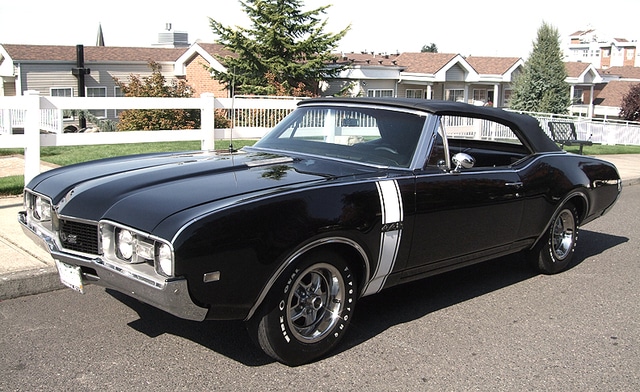 For many muscle car enthusiasts and historians the muscle car era was fist introduced to Americans by Oldsmobile in 1949. The Oldsmobile Rocket 88 is considered by most to be the very first muscle car ever produced. It had a large V-8 in a midsize car. This combination is the formula that almost all muscle car manufacturers would follow for decades to come.
For many muscle car enthusiasts and historians the muscle car era was fist introduced to Americans by Oldsmobile in 1949. The Oldsmobile Rocket 88 is considered by most to be the very first muscle car ever produced. It had a large V-8 in a midsize car. This combination is the formula that almost all muscle car manufacturers would follow for decades to come.
By the mid 60s the muscle car era was in full swing and all the major American automakers were competing to one up each other with pure horsepower. It would only seem fitting that Oldsmobile would be in the game as well since they were considered to be the originators. The muscle they offered was the Oldsmobile 442.
There is a common misconception out there that the name 442 comes from the displacement of its engine, but this is simply not true. This car came with numerous different motors, but none of them displaced 442 cu-in. The name instead comes from the configuration of having a 4-barrel carburetor, 4-speed transmission and 2 exhaust pipes. In much of the Oldsmobile literature it is written as 4-4-2 but the dashes were eventually dropped on the cars badge to simply 442. It is pronounced “four four two” and you would be pegged as a novice if you were to ever pronounced it “four forty two”.
In 1964 Oldsmobile first released the 442 as a performance package for the Cutlass in an attempt to compete with it’s cousin the Pontiac GTO. Despite the fact that Oldsmobile and Pontiac are both under the GM brand, the race to supply the muscle car demand was so intense that even internal competition was created. At the time Oldsmobile saw the Pontiac GTO as the car to beat.
The Pontiac GTO was a performance version of the mid-level Tempest. The Cutlass was built on the same platform as the Tempest so they both had an equal start. The issue that Oldsmobile faced was a rule enacted by GM that stated mid-level cars could not have engines with more than 330cu-in displacements. Pontiac did not follow the rules and used a 389 engine whereas Oldsmobile was unwilling to bend the rules and they stuck with the 330 cu-in motor. The results for the first 4-4-2 package were less than desirable when compared to the GTO. Even though the 330 engine was considerably smaller than the 389, Oldsmobile managed to rework the motor to develop 310 horsepower. The GTO’s 389 produced 325 horsepower so that gap wasn’t too great.
Seeing the restrictions it was putting on itself, GM dropped the 330 cubic inch rule in 1965 and the race was on! The 442 was given a brand new 400cu-in V8 which pumped out 345 horsepower and 440lb-ft of torque. They now claimed the name stood for 400 cubic inches, 4-barrel carburetor and 2 exhaust pipes. Of course Pontiac took full advantage of the removed restrictions and stepped up their displacement power as well, but that’s a story all its own.
In 1965 the Hurst shifter was also introduced to the market and it quickly became a must have accessory for the 442. With sales numbers still falling short of the GTO, Oldsmobile gave the world a new version of the 400 engine in 1966. This new motor had triple two-barrel carburettors to replace the original single four-barrel. The 442 was now cranking out 360 horsepower. Unfortunately this configuration only lasted one year because GM enlisted a new rule. In 1967 GM stated that the only vehicle in the entire family that could have multiple carburetors was the Corvette so it was back to the drawing board for Oldsmobile.
With sales going up in 1967 Oldsmobile had to keep the momentum going so they decided to redesign the 400 engine for the 1968 models. They gave the engine a longer stroke and a smaller bore. Although the displacement and horsepower would remain the same, the idea was to increase the torque at lower revs. Their hopes were that the 442 would perform better from 0-60, but it just didn’t pan out they way that Oldsmobile engineers and executives had hoped. Luckily for them this was the first year of the Hurst/Olds 442. It was no longer just a 442 with a few Hurst performance parts, but rather it was a special edition that was set up extremely well.
Of all the 442 models ever produced, the 1968 390-horsepower Hurst special editions are the most coveted by 442 enthusiasts. Only 515 of these units were ever made making them very hard to get your hands on! By 1969 the muscle car era was at its peak and this is when Oldsmobile released a 455 cubic-inch V8 that started out as an option, but by 1970 was the default motor for all 442s. The horsepower may have been underrated at 365, but 500lb-ft of torque would certainly put you back in your seat.
By 1971 the 442 had seen its peak and the muscle car era was coming to a close. By 1972 the 442 went back to being just a package for the Cutlass once again as it was originally. It was also merely a handling and appearance package. The huge horsepower craze had simply disappeared as the gas crisis and high insurance rates were dismantling the muscle car era.
The Cutlass kept the 442 package until 1980, but it resembled nothing of its glory years. It was brought back again for two years from 85-87 for a special version of the Cutlass Supreme. Then in 1990 the name lost all respect as Oldsmobile added the 442 name to the Cutlass Calais. This was a 180 horsepower, four-cylinder front-wheel-drive car that Oldsmobile created as a last attempt to regain sportiness. No surprise, it was a total flop. That was the last time the world would hear of the 442. Oh how the mighty have fallen.

